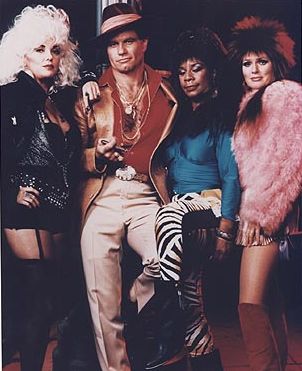
L.A. Times Article, by Beverly Stephen, 4/11/82
POLICEWOMEN: TV SHOW ON THE CASE
Can it be possible? A prime-time television series
featuring a couple of realistic women police officers? No racy
"Charlie's Angels" style glamour? A real female buddy story?
Yes, Virginia, there must be a Santa Claus. The
series is "Cagney and Lacey," starring Tyne Daly and Meg
Foster, on CBS. It is based on the successful 1981 CBS-TV
Movie Of The Week of the same name.
Lest anyone think the millennium has come, it did
take six years for the TV movie to go into production, and
much of that time was spent combating basic chauvinist
resistance, first at the movie studios, then at the networks.
At one point, a film company suggested pairing Raquel
Welch and Ann-Margret as Cagney and Lacey. But in the
end, the film was not exploitative. The police officers are
presented as mature women, not as girls or as sex
objects.
Chris Cagney is single, tough and adventurous.
Mary Beth Lacey is more cautious and nurturing. She
struggles with working mother's guilt and the problems
of a husband facing unemployment. The result is still
entertaining and funny as well as a reasonably realistic
portrayal of the officers and their working relationship.
Just how realistic? We asked some women
officers in the New York Police Department who had
seen the pilot and were pleased that a series had resulted.
We spoke with Pat Holmes, president of the
Police Women's Endowment Assn. and with officers
Maria Fitzgerald and Mary DellRocca, who have worked
as partners.
Good To See
"It was a little glamorized and there were a
few technical flaws, but basically it was good to see
female officers on television," Holmes said. "'Cagney
and Lacey' will probably be good for recruitment. More
women may want to take the exam."
"They did some things we would never do," Dell-
Rocca explained. She cited a scene in the film, for
example, in which the partners, on a roof with guns
drawn, look through a skylight at people measuring out
white powder.
To make the arrest, they lift the skylight, point
their guns inside and shout, "Freeze! Police!"
"Any officer would call for help first," DellRocca
said. Referring to another scene, she added. "It would
be highly unusual to go out on your own time alone. You
don't jeopardize yourself like that.
"I'd like to see them say, 'Oh my God, what are
we doing here?' the way we really do," DellRocca said.
When DellRocca and Fitzgerald worked together
as partners on patrol, it was unusual because there were
so few women officers. Today there are about 1,400 women
in a force of 18,000 and 95 are detectives. "When women
first went on patrol in 1973, they would separate us because
they felt responsible. When we did work together, our lieutenant
acted like a Big Daddy, and he'd be right behind us
saying, 'Are you alright?' But then he saw we were doing a
good job and laid off. And when they saw some of the men
we were working with, they said, 'Christmas, why worry about
them working together?'" Fitzgerald said.
"We were stuck riding with guys other guys wouldn't
work with," Holmes said.
Share of Razzing
These women have taken their share of razzing from
fellow officers and public alike, as have all women entering
predominantly male professions. But they like the variety and
excitement of their work and the money they earn. In the film
one of the officers is married and the other single. The police
officers we spoke with are all married...to other cops. "It's difficult
going around the clock if you're not married to a cop. A
shoe salesman doesn't understand if you're not there to make
dinner," Fitzgerald said.
As more of the younger officers come up through the
academy with women, they are getting used to the presence
of women on the job. "In the beginning the guys would carry
on and say, 'Hey, here they come.' And the guy you were
going to ride would start putting on Old Spice all over himself,"
Fitzgerald said. "But the young ones have been with women in
class, in the gym, everywhere. They're used to it."
"The public," DellRocca recalled, "was used to dialing
911 and getting two burly guys. And when we came they would
say, 'Oh, they sent you?'"
On the more positive side, Holmes noted that "a lot of
women are very happy to see us in family-abuse or rape cases.
But it's going to take a lot more time and a lot more women officers
before everybody gets used to us."
Like all women in non-traditional professions, women
officers are aware that the public judges all women officers on
the performance of one. Says Fitzgerald, "If someone takes a
gun away from a male rookie, nobody talks about it. If it happens
to a woman, it makes headlines. The public is judging not only me
but every policewoman in the city. So I have a responsibility to do
my job right."
Women still make up a small percentage of the police
force and an even smaller percentage of its management. The
female officers still believe they face discrimination in both the
hiring and promotion process and in the way they are perceived
by colleagues, the public and the media. If a series like "Cagney
and Lacey" makes even a small dent in that perception, it purpose
will have been served.
***This article was sent to me by Scott. Thanks, Scott!

Back to start of Cagney and Lacey section
My Index Page
|